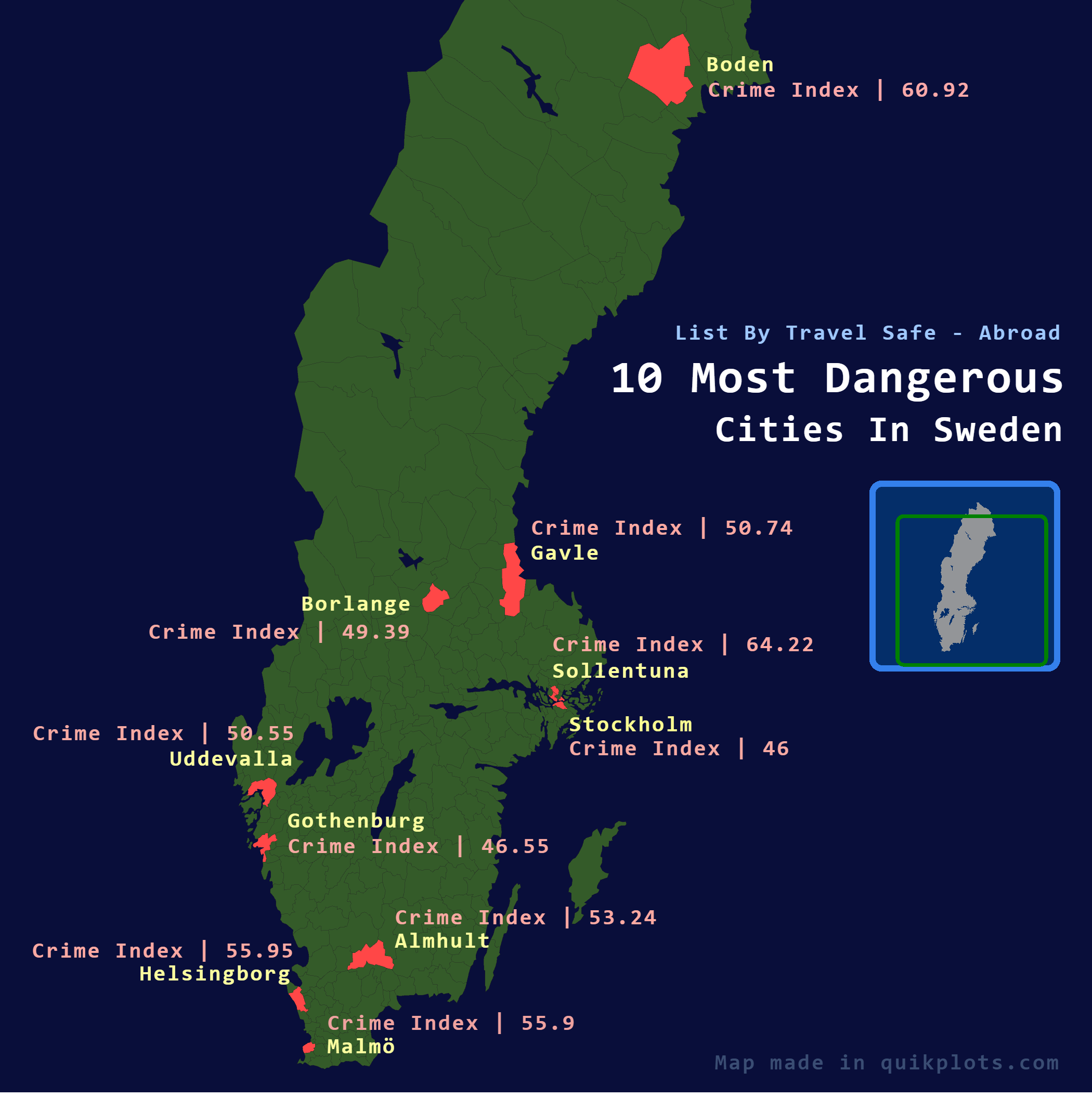10 Most Dangerous Cities in Sweden Map


Marcus Rodriguez
Historical Geography Expert
Marcus Rodriguez specializes in historical cartography and geographic data analysis. With a background in both history and geography, he brings unique...
Geographic Analysis
What This Map Shows
The map titled "10 Most Dangerous Cities in Sweden" provides a visual representation of urban safety across Sweden, highlighting areas with higher crime rates. Each city is marked, allowing viewers to quickly identify locations that may pose safety concerns for residents and travelers alike. This visualization is crucial for understanding regional dynamics related to crime and safety in Sweden, a country often regarded as one of the safest in the world.
Deep Dive into Urban Safety in Sweden
Interestingly, while Sweden is celebrated for its high living standards and low crime rates compared to global averages, certain cities do experience elevated crime levels. The cities identified as the most dangerous often face challenges such as socioeconomic disparities, urban density, and nightlife-related incidents that contribute to crime rates.
For instance, cities like Malmö and Gothenburg frequently appear on lists ranking dangerous areas due to their higher occurrences of violent crimes and property offenses. According to the latest statistics from the Swedish National Council for Crime Prevention, Malmö has been experiencing a surge in gang-related violence, which has drawn considerable media attention. The city's challenges can be traced back to various factors, including immigration, social integration, and economic opportunities.
Gothenburg, Sweden's second-largest city, faces similar issues, particularly in districts with higher unemployment rates. Here, the crime statistics reflect a complex interplay between poverty and crime, where young individuals may turn to illegal activities due to a lack of viable opportunities.
On the other hand, cities like Stockholm, while they do experience crime, have more resources and a higher police presence, which helps mitigate serious offenses. Yet, in tourist-heavy areas, petty crimes such as pickpocketing are common, prompting authorities to continually enhance public safety measures.
What's fascinating is how crime rates can fluctuate over time due to various interventions and community programs aimed at reducing violence. Initiatives focusing on youth engagement and social services are being implemented in several of these cities to address the root causes of crime and improve safety overall.
Regional Analysis
When we break down the map by regions, distinct patterns emerge. For example, the southern regions, particularly Skåne County, where cities like Malmö and Helsingborg are located, tend to report higher crime rates than northern areas like Norrland. This discrepancy can be attributed to population density; southern cities are more populated and urbanized, which often correlates with higher crime rates.
In contrast, cities in northern Sweden, such as Umeå and Luleå, are generally considered safer. The smaller population size and lower urban density contribute to a different social dynamic, where community ties are stronger and crime is less prevalent.
Interestingly, even within metropolitan areas such as Stockholm, crime rates can vary significantly by district. Areas like Södermalm are known for their vibrant nightlife and youthful energy but also see higher instances of intoxication-related offenses. In contrast, more affluent areas like Östermalm report lower crime rates, emphasizing the impact of socioeconomic status on urban safety.
Significance and Impact
Understanding the safety landscape of Swedish cities is crucial for both residents and travelers. It affects choices regarding where to live, work, and explore. Rising crime rates in certain cities can lead to increased insurance costs, decreased property values, and can even deter tourism, which is vital for local economies.
Furthermore, the ongoing dialogue about safety impacts public policy and law enforcement strategies. Authorities are continually adapting their approaches to crime prevention, focusing on community engagement and collaborative efforts with residents to foster safer environments.
As we look towards the future, trends indicate that cities experiencing higher crime rates may need to invest more in social programs and educational initiatives to address the root causes of crime. The relationship between urban safety and social equity cannot be overstated; as cities evolve, promoting safety and community well-being will be essential for sustainable urban development in Sweden.
In conclusion, while the map highlights the most dangerous cities in Sweden, it also serves as a reminder of the complexities surrounding urban safety. It encourages us to reflect on the broader social dynamics at play and the importance of fostering inclusive communities that prioritize safety for all.
Visualization Details
- Published
- October 2, 2025
- Views
- 42
Comments
Loading comments...